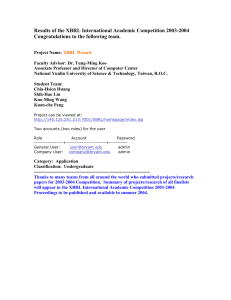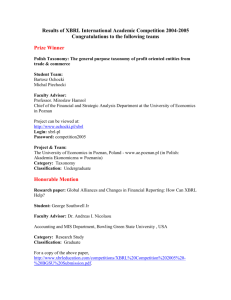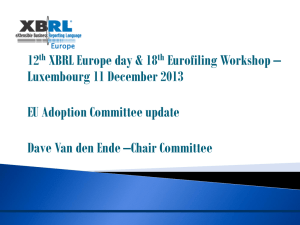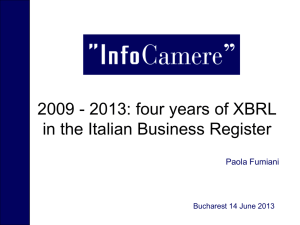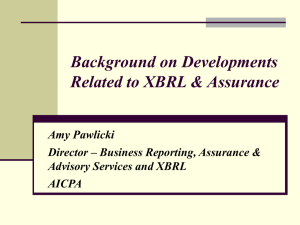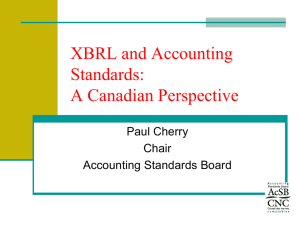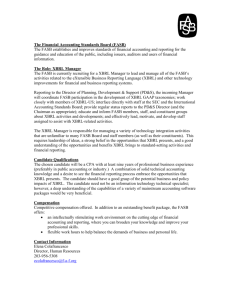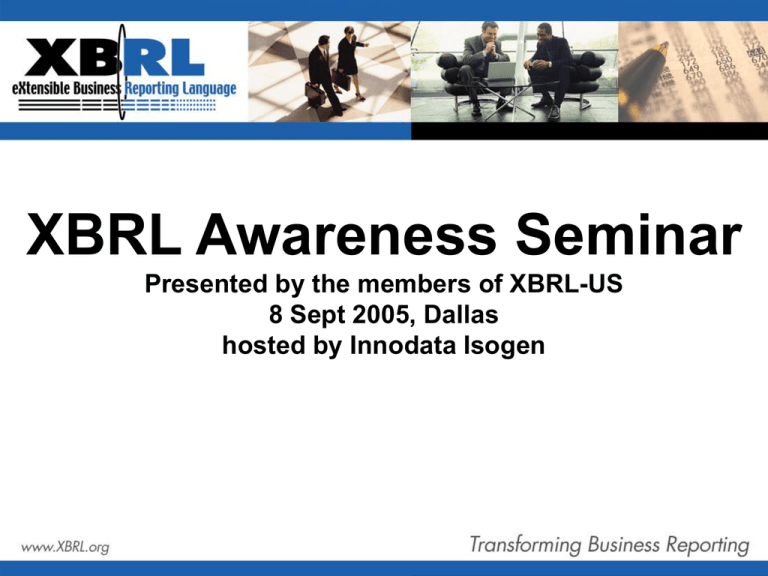
XBRL Awareness Seminar
Presented by the members of XBRL-US
8 Sept 2005, Dallas
hosted by Innodata Isogen
Agenda
Welcome
Overview of XBRL; the need for standards (what)
Benefits of XBRL (why)
Overview of the SEC VFP; preparation case
study
Technical overview (how)
Wrapup and Q&A
XBRL Overview
What’s the Problem?
Business reporting information producers,
processors, and consumers all looking for
increased efficiency
Increasing costs of manual processing
Increasing demands for additional processing (e.g.
Sarbanes-Oxley requires SEC to do more checking)
Analysts need to track more firms, look at more
information for each firm
Manual processing (i.e. rekeying) prone to errors
Reuse, repurposing of information expensive
Why Change Business Reporting?
Data Preparer Pressures:
Users/consumers are demanding more complete,
timely data
Data is more complex
Required to report more often, more quickly
Need to decrease costs
Data User/Consumer Pressures:
Greater transparency and detail
Easier to process and make decisions
Act more quickly
Need to decrease costs
2
Today’s Business Reporting Tools Obsolete
Not the right information
Too late
Need for continuous reporting
Delivered in an unusable fashion
The “paper paradigm” and manual reentry
Too little
Current methods require “no more, no less”
Different stories for different people
A million forms, the same information, in different ways
Others offer more frequent, more usable solutions
At best, the “Story” is clouded
At worst, rumor, gossip, innuendo
Consolidated Profit and Loss Account
for the year ended December 31, 2004
Blah
blah
blah
Blah blah
blah
blah
Blah
blah
blah
Blah blah blah
blah
blah
Profit
925
448
Blah
blah
blah
Earnings per share
3.6
11.0
Time to move into the 21st Century
The Star Trek test: how should it work?
Can Automation Help?
Yes, but automation requires
1. Intelligent financial data
2. An agreement on how to describe the information, i.e.
a Standard
1. Intelligent Data
Data that knows about itself; self-describing
HTML/PDF are electronic, but not intelligent
Simply an electronic version of a paper document; not
much better than a fax
“The problem with WYSIWYG is that’s all you get”
PDF not any better than an OCR’d printed report; data
still needs to be manually rekeyed and analyzed
Example: FDA is moving away from PDF and towards
XML for pharmaceutical approval applications
XML to the Rescue
Extensible Markup Language
A meta-language: a language to describe other
languages; a syntax for describing information
Semantics/meaning of information, rather than
appearance/presentation of information
You Can Probably Figure This Out
In the following example, what does “1211”
represent?
XBRL International
1211 Avenue of the Americas
19th floor
New York, NY 10036
www.xbrl.org
Easy for humans because context defines the
semantics of the content – but more difficult for
machines
But What’s This?
37
HTML Doesn’t Help…
<b>37</b>
…but XML Does
<OperatingProfit decimals="6"
unitRef="USD">37</OperatingProfit>
XBRL and XML
XBRL is an application of XML, a means of
describing financial information using XML syntax
Intelligent data that can be
Reused
Repurposed
Exchanged/submitted
Machine processed
XBRL the Next Big Thing
Gartner lists XBRL as one of four “Next
Generation Architectures” together with Service
Oriented Architecture, Web Services Enabled
Business Models, and Business Process
Platforms
“Next Generation Architecture will constitute the third big
era in the IT industry’s history (the first having been the
hardware era and the second belonging to software).”
(23 Aug 2005)
2. Need for Standards
For intelligent information exchange to work we
need agreed-upon ways to describe the
information
Examples of standards
Electrical plugs and sockets
Traffic laws
Fax machines
Railroad gauges
The Railroad Example
Business Reporting Supply Chain
Processes
Business
Operations
XBRL
Internal
Financial
Reporting
External
Financial
Reporting
XBRL
XBRL
Financial
Publishers
and Data
Aggregators
Companies
Participants
Trading
Partners
Investment,
Lending, and
Regulation
Management
Accountants
Auditors
Software Vendors
Regulators
Investors
Intangibles
Lower cost of producing, delivering information
Accuracy, timeliness, and other efficiencies from
“straight-through” processing
Tell your own story (precise & clear)
Completeness and timeliness of data leads to
enhanced analytical capabilities
Accelerated adoption of reporting model changes
Environment conducive to harmonization
These benefits shared throughout the entire
corporate reporting supply chain
Two Things Named “XBRL”
XBRL is a technology used for financial reporting
XBRL is a consortium formed to promote the
adoption of the technology
The XBRL Technology
XBRL specification: defines XBRL taxonomies
and instances
XBRL taxonomies: the set of elements (tags)
used to define your data
XBRL instances: the file containing financial
information that you create and deliver
The XBRL International Consortium
A worldwide consortium of participants in the
business and financial information supply chain.
Oversee the creation, development, submission
and maintenance of the XBRL specification and
related taxonomies for business & financial
reporting data
The XBRL-US Jurisdiction
“The mission of XBRL-US is to make XBRL the
de facto standard for all internal and external
business reporting for U.S. organizations”
XBRL US Member Companies
Adobe Systems
AICPA
AIG
Allocation Solutions
BDO Seidman
Booz Allen Hamilton
Bowne & Co.
Business Objects
Business Wire
Capital Printing Systems
Capricorn Research
CCH Tax and Accounting
Cognos
Creative Solutions
Deloitte & Touche
Dynamic Access System
EDGAR Filings
EDGAR Online
Ernst & Young
FactSet Research Systems
FDIC
Financial Executives International
Forum Systems
Fujitsu
GCom2 Solutions
Grant Thornton
Hitachi America
Innodata Isogen
Institute of Management Accountants
Ipedo
KPMG
Merrill
Microsoft
Morgan Stanley
PR Newswire
PricewaterhouseCoopers
PTC
RIA Compliance/Thomson
Rivet Software
RR Donnelley
R.S. Rosenbaum
SAS Institute
SavaNet
SimpleX Data Technologies
Standard Advantage
UBMatrix
Xaware
Importance of XBRL
Joe Petersen, Innodata-Isogen
Benefits of XBRL
Kelly Ray, Director Advisory Services,
PricewaterhouseCoopers
What Leading CFOs Are Saying
CFO Research*
January 2005
Key Finding:
Finance personnel need to
develop more finely honed
business and technology skills
– as opposed to technical
skills – to take advantage of
the time that streamlined
processes and optimally
deployed technology will
afford them.
* - Findings taken from a PwC research project sponsored by
CFO magazine focusing on the role of the CFO as a Chief
Performance Advisor.
“ . . . 55% of senior finance executives
contend they need more businesssavvy staffers working for them”
“ . . . CFOs are considering how to
transform Finance from primarily a
process and organizer of information
into something far more valuable.”
“ . . . 58% of survey respondents say that
over the next three to five years they plan
to invest in building their finance team’s
knowledge of the business and the
environment in which it operates.”
“ . . . fewer than 20% say that they have
programs in place to improve their team’s
business analysis, communication,
problem solving and related skills.”
XBRL and the Simplification Strategy
Business
agility
Financial efficacy
Process and
operational efficiency
Information quality
Technological flexibility
Human capital satiability
Strengthening performance
management, budgeting and
forecasting
Optimizing cash flow and the
use of capital
Building and maintaining costeffective controls
Improving internal and
external reporting
Orchestrating existing systems
Focusing on people and
organizational structure
People as a Key Concern
Note the key change from 2003 to 2004 in
the concern about the loss of key talent.
EXHIBIT 2 THREATS TO BUSINESS GROWTH—
YEAR-TO-YEAR COMPARISON
What are the potential threats to business growth prospects?
2003
-10
Overregulation
2004
-30
41
Increased competition
-10
-25
Loss of key talent
-16 -37
Reputational risk
-25 -36
25 10
Terrorism
-16 -41
30 10
-80%
No threat
at all
18
46
17
34 11
0%
-10
-29
40
-13
-32
33
21
-12
-34
40
14
-25 -33
-23
A minor
threat
28 13
-39
60% -80%
20
28 8
0%
A significant
threat
©2005. All rights reserved. PricewaterhouseCoopers, LLP
8th Annual CEO Survey
60%
One of the
biggest threats
Drivers:
•Key talent want to be stimulated
•Don’t want paper shuffling/data
entry
•Key talent want to be recognized
•Want to be associated with valueadded activities
•Key talent want quality of life
•Burnout is plaguing
Options:
Historically - Throw more people at the
problems (data aggregation,
budgeting/planning, consolidation,
report generation)
•High cost of talent -> Offshoring/
Outsourcing
Applying Trends to People Concerns
EXHIBIT 9 VALUE OF OFFSHORING—BY REGION
What are your perceptions of offshoring?
HELPS TO REDUCE COSTS
-3
United States
35
-2 -3
Europe
South America
-5 - 4
Asia-Pacific
-2 -5
-60%
Strongly
disagree
-6 -11
44
25
45
0%
-2 -10
46
32
19
RAISES OPERATIONAL RISK
-8
-11 19
80% -60%
Somewhat
disagree
0%
While U.S. CEOs believe offshoring
reduces costs, they also believe it
raises operational risk.
16
5
39
Somewhat
agree
©2005. All rights reserved. PricewaterhouseCoopers, LLP
8th Annual CEO Survey
16
41
-5 -12
25
45
Better to reduce risk while reducing
cost through improved financial
processes and automation
7
80%
Strongly
agree
Benefits of XBRL – Talent Retention
Business
agility
Financial efficacy
Process and
operational efficiency
Information quality
Technological flexibility
Human capital satiability
XBRL allows for:
√ Key talent redirected to value-added
analysis – stimulated/recognized
Rules engines working with XBRL to
perform low-level analytics
√ Reduced effort to close and report –
minimizing burn-out
Reduced data entry/ transformation
Automated consolidation
Benefits of XBRL - Sustainability
Business
agility
Financial efficacy
Process and
operational efficiency
Information quality
Technological flexibility
Human capital satiability
XBRL and Web Services:
√ Do not require a single, massive, system-wide
implementation.
√ Sustainable, flexible architecture that does not
depend on a single vendor and is platformindependent
√ Allow disparate systems to “talk” to each other
more efficiently and effectively
Across languages
Across data definitions
Across file formats
√ Uses existing business rules and is easy to
modify when a change in business rules occurs,
which is the significant advantage over
traditional hard-coded systems
√ Enable platform integration in a short time with
limited investment:
XBRL can be deployed incrementally
√ Enhanced data protection for critical data
Benefits of XBRL - Transparency
Business
agility
Financial efficacy
Process and
operational efficiency
Information quality
Technological flexibility
Human capital satiability
XBRL allows for:
√ Ability to more easily trace information directly
to its originating source;
√ Single definition of reliable data for multiple
reporting uses
√ Lowered risk of error via reduced manual
processing and reconciliations
√ Improved data re-usability and data quality as
a natural byproduct of reduced rekeying
√ Enhanced format flexibility
√ Richer contextual understanding
√ Validating data as it moves in and out of
spreadsheets or applications
√ Validation closer to sources
√ Consistent validation
If we click on a market
segment in the
table, such as
Inbound Corporate”,
we get a description
of what that means
(from the XBRL
Label Linkbase)
Benefits of XBRL – Simplification
Business
agility
Financial efficacy
Process and
operational efficiency
Information quality
Technological flexibility
Human capital satiability
XBRL allows for:
√ Reduced cycle time
√ Lowered risk of error via reduced manual
processing and reconciliations
√ Improved data re-usability and data quality as
a natural byproduct of process efficiency
√ Enhanced control and improved quality by
removing manual processing
√ Integration of processes across parties
√ Alignment with recent industry and regulatory
standards and processing initiatives
Case Study: Financial Service Firm
Issues and Implications
$
x 26
$
Financial Services
Firm
Minimize Redemptions
Sales
60 hrs/month
x 26
Raise New Funds
x 30
2 hrs/month
Wish List:
Maximize Fund
Performance
x 60
Biz Rules
50 hrs/month
1.
Custom Fin. Adv. Rpt (100+)
2.
Ad-hoc reports
3.
Fund Statistics
4.
Historical Data
Case Study: Financial Service Firm
Results
$
$
Minimize Redemptions
Sales
10 minutes/month
Redemption Reports:
2 hrs/month
Raise New Funds
Granted Wish List:
Maximize Fund
Performance
Biz Rules
1 hrs/month
1.
Custom Fin. Adv. Rpt (100+)
2.
Ad-hoc reports
3.
Fund Statistics
4.
Historical Data
Automating the Control Environment
XBRL strengthens management
controls by establishing direct
information feeds from enterprise
systems to monitoring tools
©2005. All rights reserved. PricewaterhouseCoopers, LLP
May, 2005 Barometer Survey through CFODirect Network
Improving the Quality of the Control
Environment
Today
Manual
Periodic
Physically connected to
Internal data store
Segregated in each
business unit/redundant
costs
Reactive/untimely
Opaque/ deep in
organizational processes
Less secure
XBRL Web Services
Automated
Persistent
Embedded in data process
flows - Optimized
Integrated within enterprise
processes/cost effective
Proactive/timely
Visible/transparent to
management stakeholders
More Secure
Benefits of XBRL – Value-Add
Business
agility
Financial efficacy
Process and
operational efficiency
XBRL allows for:
√ Fewer resources required for report production
√ Reduction in production costs and timeframes
√ Enhanced returns on IT resources,
investments and initiatives
√ Lower technical support costs, which enables
IT to focus on expanding functionality
√ Reduced costs of audit and assurance for
routine matters
Information quality
Technological flexibility
Human capital satiability
Forrester estimates that companies pay workers $404 billion to retrieve, re-key and
search for information which is 11% of all wages paid in the U.S.
FFIEC
Federal Financial Information
Examination Council
FDIC
Federal Deposit Insurance
Corporation
OCC
Office of the Comptroller of
the Currency
FRB
Federal Reserve Bank
OTS
Office of Thrift Supervision
NCUA
National Credit Union
Administration
FFIEC Processing – Before and After
Multiple copies of data exist
inside multiple agencies (error
prone)
Average of 60 – 75 days to
receive, validate + publish
filings (not timely)
Estimated processing costs over
next 10 years - $65 million
(costly)
March 2003 reports had nearly
18,000 errors that needed to be
corrected (integrity issues)
1,000 basic math errors
17,000 quality (validation)
errors
XBRL open source data standard
used for communicating report
requirements, validations,
instructions (integrity, flexibility)
Filers required to submit data in
XBRL format over the web
(automation)
Multiple sources of data to a
single standard (integrity)
Processing Time 60-75 days
2 Days (timeliness)
Processing Costs $65M
$39M, a savings of $26M (cost
efficiencies)
Benefits of XBRL – Strategic Alignment
Business
agility
Financial efficacy
Process and
operational efficiency
Information quality
Technological flexibility
Human capital satiability
XBRL allows for:
√ Faster turn around between events and
decisions
√ Expanding the scope of management analysis
through faster data access and re-use, which
allows more data points to be included routinely
√ Making decisions/judgments based upon
higher quality information
√ Transparency via tailored, customized
reporting
√ Adaptability to changes in reporting models
√ Promoting instant internal and external report
creation at any time
√ Enabling companies to track non-financial
metrics, including value drivers, which are
difficult, if not impossible to monitor on an
ongoing basis.
XBRL value proposition
Businesses:
More efficient preparation of
financial statements and
management reporting
Financial reports created
once and re-used many
times, e.g. as printed reports,
Web pages, or regulatory
filings.
Financial Publishers and
Data Aggregators:
More efficient data collection
Avoid costs associated with
custom data feeds and rekeying
Fewer errors
More time to focus on analysis
Analysts, Investors and
Regulators:
Enhanced distribution and
usability of existing financial
statement information
Automated analysis tools
Less re-keying of financial
information.
Software Vendors:
Use XBRL for data export and
import (e.g. transactions and
reports)
Potential for full interoperability
with other financial and
analytical applications
SEC VFP overview, case study, and
technical overview
Wayne Harding, Rivet Software
SEC VFP Overview and Case Studies
Why the SEC needs help…
see also: sec.gov/spotlight/xbrl.htm
700000
600000
500000
400000
# of Filings
Avg size
300000
200000
100000
0
2000
2001
2002
Source: EDGAR On-line
2003
2004
2005*
* = filings annualized based on 6 months
Why is the SEC doing this? – SOX!
Section 408 -- Enhanced Review of Periodic Disclosures by Issuers :
a. Regular and Systematic Review. The Commission shall review disclosures
made by issuers reporting under section 13(a) of the Securities Exchange Act of
1934 (including reports filed on Form 10-K), and which have a class of securities
listed on a national securities exchange or traded on an automated quotation
facility of a national securities association, on a regular and systematic basis for
the protection of investors. Such review shall include a review of an issuer's
financial statement.
b. Review Criteria. For purposes of scheduling the reviews required by subsection
(a), the Commission shall consider, among other factors-1. issuers that have issued material restatements of financial results;
2. issuers that experience significant volatility in their stock price as compared to other
issuers;
3. issuers with the largest market capitalization;
4. emerging companies with disparities in price to earning ratios;
5. issuers whose operations significantly affect any material sector of the economy; and
6. any other factors that the Commission may consider relevant.
c. Minimum Review Period. In no event shall an issuer required to file reports
under section 13(a) or 15(d) of the Securities Exchange Act of 1934 be reviewed
under this section less frequently than once every 3 years.
SEC Voluntary Filing Program –
Final SEC Rules
• Amendments to Regulation S-T establish
voluntary program
• EDGAR Filer Manual updated for XBRL upgrade
to EDGAR system
• Voluntary Filing Program commenced
April 4, 2005
• Volunteers may furnish supplemental financial
information using XBRL
• Official HTML or TEXT filings still required
SEC Voluntary Filing Program –
Form of Submissions
XBRL documents are furnished as Exhibit 100 to:
• Exchange Act periodic reports
• Exchange Act Reports on Forms 8-K or 6-K
• Investment Company Act filings
XBRL documents are disseminated on EDGAR
SEC Voluntary Filing Program –
Description of XBRL Data
Volunteers must provide disclosures about the XBRL
documents:
Use cautionary language
Users of this data are advised pursuant to Rule 401 of Regulation S-T that the information contained in the XBRL
documents is unaudited and these are not the official publicly filed financial statements of ABC Corporation. The
purpose of submitting these XBRL formatted documents is to test the related format and technology and, as a
result, investors should continue to rely on the official filed version of the furnished documents and not rely on this
information in making investment decisions.
In accordance with Rule 402 of Regulation S-T, the information in this Current Report on Form 8-K, including
Exhibit 100, shall not be deemed to be “filed” for purposes of Section 18 of the Securities Exchange Act of 1934, as
amended (the “Exchange Act”), or otherwise subject to the liability of that section, and shall not be incorporated
by reference into any registration statement or other document filed under the Securities Act of 1933, as amended,
or the Exchange Act, except as shall be expressly set forth by specific reference in such filing.
Describe as “unaudited” or “unreviewed”
Forms 8-K and 6-K must reference the official filing to
which the data relates
SEC Voluntary Filing Program –
Content of XBRL Documents
Mandatory Content:
• Complete set of financial statements, however:
• Notes to financial statements may be omitted,
• Schedules may be omitted, but IM companies must
include Schedule I – Schedule of Investments
or
• Earnings information in a Form 8-K or 6-K
or
• Financial highlights or condensed financial
information for IM companies
SEC Voluntary Filing Program –
Content of XBRL Documents
Optional Content:
• Audit opinion
• Interim review reports
• Reports of management on the financial
statements
• Certifications
• MD&A (or MDFP for IM companies)
SEC Voluntary Filing Program –
Registrants Have Flexibility
The VFP program does NOT:
Limit participation by size, specific industry, or type of
registrant.
Impose any filing deadlines:
Furnish no earlier than the related Exchange Act filing
Impose a minimum level of tagging beyond financials (i.e.,
volunteers have flexibility in determining the nature and extent
of tagging).
Require volunteers to certify the XBRL-related documents.
Require auditors to attest to the financial information included
in the XBRL-related documents.
Require participation for a set period of time (free to start or
stop any time).
The Program has established appropriate liability protections for
volunteers and allows participants to resubmit XBRL-Related
Documents, if deemed necessary.
Case Study - Motivations to Participate in
SEC Voluntary Filing Program
Better Understand and Evaluate XBRL
Improve Usability of Reports for
Stakeholders: Investors, Lenders,
Regulators
Market place positioning
Prepare to Comply with Potential Future
Mandates to use XBRL in Filings
Improve Internal Efficiency of Financial
Reporting
Case Study - Approach
Created cross-functional team (Finance,
Marketing, Operations, IT, IR, etc.)
Educate, educate, educate
Decide on initial approach and obtain Executive
buy-in
Case Study – Business Decisions
WHO?
Identify Project Leader
Determine team members
Assess level of internal and external expertise needed
WHAT?
Should we file our own XBRL?
Which document should we choose?
How deep should we tag (F/S, MD&A)?
Should a rendering/viewing be created to proof XBRL?
Internal sign-off?
Legal for 8-K / Finance for XBRL
Additional steps after SEC submission (website, IR
activities, internal awareness)?
Case Study – Business Decisions
WHEN?
Start with 12/31/04 year-end information or 2005
quarterly information
Expected Frequency: once or periodically?
HOW?
At which data point should information be tagged in
XBRL (e.g., ERP, G/L, Word document)?
Select core taxonomy to be used
Which software should be utilized?
Which processes should be followed in order to create,
review, validate, submit and post the Instance
Document and Taxonomy Extension?
Case Study - Process
Following official filing, map line items to existing
tags and flag items to go in extension taxonomy
Populate data
XBRL level validation
SEC level validation
Render and proof
Test under EDGAR system (and re-test)
File with SEC
Case Study Observations
The first time a company places their financials in
XBRL requires a significant time commitment.
The company will have to map tags to each data
point on their financials.
Subsequent forays take significantly less time
since the tags have been previously established.
Ask for HELP
Feel free to ask SEC Staff about the
Voluntary Filing Program
Jeff Naumann naumannj@sec.gov, Brigitte Lippmann or any of the
other names listed on the final rule release
(www.sec.gov/rules/final/33-8529.htm)
General inquiries: xbrlprogram@sec.gov
Other Resources
www.XBRL.org
Accounting professionals
Filing agents
Software vendors
Rivet Software’s SEC Filing Guide
www.rivetsoftware.com
Case Study – XBRL – Business Reporting
Equivalent of the Barcode
Efficiency
Savings
Quality
So….
How do we create the
“business barcode”?
The “Technical Overview”
Revisiting 2 quotes:
“XBRL is to the “printed” annual
report, what the internet is to
the printed Yellow Pages.”
“Complex information can be turned into simple knowledge!”
And add two more…
Information that is easier to use will be used more!
The key is to make information structured.
Think of a spreadsheet…
200,000
Think of a spreadsheet…
$ 200,000
Think of a spreadsheet…
Revenue
$ 200,000
Think of a spreadsheet…
Year ending 2004
Revenue
$ 200,000
Financial
Statements
Consumers of
Financial
Statements
Apply XBRL Core
Schema
Apply “Taxonomy”
Financial
Statements
Extend “Taxonomy”
(if needed)
Instance Document
Creation
Consumers of
Financial
Statements
Web Site (formatted
via a “style sheet”)
Analytics (e.g., Edgar
On-Line iMetrics)
New Releases
Via PR Newswire
Regulatory Filings
To Create an XBRL Document
(“Instance Document”)
Native within your ERP or reporting application
Oracle
SAP
SAS
Hyperion
Part of a suite – MBS and FRx
Third party tools
Hitachi
Fujitsu
Rivet
To Create an XBRL Document with Rivet
Use Excel™ and Word™
Establish the Entity
“Tag” the data
Validate the data
Export into an instance document
Establish the Entity
“Tag” the data
Validate the data – Part One - Viewer
Validate the data – Part II
Export into an Instance Document
Who’s In the Kitchen?
Finance Department
Preparation of financials
IRO
Earnings News Release
External Auditors
PCAOB guidance
Road Blocks – Why not do XBRL
Mis-information
Such as … disclose more?
Costs
Learning curve
Application purchase
Labor hours
“No time”
Sometimes payback is hard to quantify
Remember:
“XBRL is to the “printed” annual
report, what the internet is to
the printed Yellow Pages.”
Complex information can be turned into simple knowledge!
Information that is easier to use will be used more!
The key is to make information structured.
Wrapup
Summary of Presentations
XBRL Overview
Benefits of XBRL
SEC Voluntary Program; Case Study
Technical Overview
Available Resources
FAQs, tutorials, case studies, list of available
tools, specifications, presentations, etc.
www.XBRL.org
www.XBRL.org/US
Public discussion email list
http://finance.groups.yahoo.com/group/xbrl-public/join
Unofficial websites
http://www.xbrlspy.org/
http://xml.coverpages.org/xbrl.html
http://bryant2.bryant.edu/~xbrl/
Call to Action: XBRL-US Membership
Organizational or Individual/Academic
memberships
Includes membership in International consortium
Benefits of membership:
Participation in creation of specifications; set direction
of specs, make sure they meet your needs
Early access to specifications; first to market
Networking with XBRL experts
Exposure as supporter of XBRL
For more information see www.XBRL.org/US/join
Call to Action: Participate in SEC VFP
Markup your financials in XBRL
Submit to SEC
Webcast
Tomorrow and Monday
www.xbrl.org/us/events
Q&A

